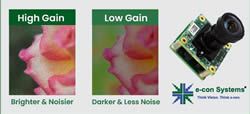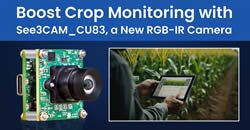How Cameras Power AI-Driven Autonomous Weeding Robots in Precision Agriculture
Autonomous weeding robots are modernizing agriculture by using AI vision capabilities to identify and remove weeds with speed and consistency. They rely on high-quality imaging to distinguish weeds from crops, even at early stages of growth.
What Is a Camera Module - And What Are Its Components?
Camera modules can be integrated into embedded vision devices like drones, industrial equipment, etc. They consist of components such as sensors, lenses, interfaces, and more. Get expert insights into how they work, their popular types, and more.
How Are Gain and Image Quality Related?
Gain refers to the amplification of the signal from the image sensor to ensure that the imaging process meets defined purposes. However, trade-offs may occur in some cases. Learn about the types of gain, their differences, and their relationship with image quality.
What is Interpolation? Understanding Image Perception in Embedded Vision Camera Systems
Interpolation is a mathematical technique used to estimate unknown values that lie between known data points. Interpolation helps transform raw sensor data into stunning, full-color images in embedded vision systems.
Boost Crop Monitoring with See3CAM_CU83, a New RGB-IR Camera
Boost crop monitoring with e-con Systems' See3CAM_CU83 RGB-IR camera. Capture visible and NIR light for early stress detection, NDVI mapping, and improved crop health, offering cost-effective, real-time insights.
What Causes Blooming Artifacts in Microscopic Imaging and How to Prevent Them
Advanced camera technologies are used with microscopes for diagnostics in the medical and life sciences industry. The occurrence of different types of imaging artifacts is a major challenge faced in microscopic imaging.
Optical Zoom vs. Digital Zoom: See What Best Suits Your Embedded Vision Application
There are two major approaches to camera-related magnification - optical zoom and digital zoom. One relies on manual adjustments while the other leverages software algorithms. Explore the differences, advantages, and limitations of both these approaches.
Robot Solution for Automating the Lettuce Harvest
The lettuce's outer, or 'wrapper', leaves will be mechanically removed to expose the stem. Machine vision and artificial intelligence are then used to identify a precise cut point on the stem to neatly separate the head of lettuce.
Records 1 to 8 of 8
Featured Product

agrierp - Your One-Stop Farm Management Software
AgriERP is an all-in-one, comprehensive farm management suite, built by the farmers for the farmers to maximize profits. Built on the powerful ERP of Microsoft Dynamics 365, AgriERP enables farming enterprises to manage every aspect of their farm from financial management, inventory management, supply chain & logistics management, crop management, operations management, resource management, to sales, contracting, & shipping - All in a centralized platform.








